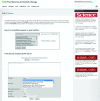PGSB PlantsDB: updates to the database framework for comparative plant genome research
- PMID: 26527721
- PMCID: PMC4702821
- DOI: 10.1093/nar/gkv1130
PGSB PlantsDB: updates to the database framework for comparative plant genome research
Abstract
PGSB (Plant Genome and Systems Biology: formerly MIPS) PlantsDB (http://pgsb.helmholtz-muenchen.de/plant/index.jsp) is a database framework for the comparative analysis and visualization of plant genome data. The resource has been updated with new data sets and types as well as specialized tools and interfaces to address user demands for intuitive access to complex plant genome data. In its latest incarnation, we have re-worked both the layout and navigation structure and implemented new keyword search options and a new BLAST sequence search functionality. Actively involved in corresponding sequencing consortia, PlantsDB has dedicated special efforts to the integration and visualization of complex triticeae genome data, especially for barley, wheat and rye. We enhanced CrowsNest, a tool to visualize syntenic relationships between genomes, with data from the wheat sub-genome progenitor Aegilops tauschii and added functionality to the PGSB RNASeqExpressionBrowser. GenomeZipper results were integrated for the genomes of barley, rye, wheat and perennial ryegrass and interactive access is granted through PlantsDB interfaces. Data exchange and cross-linking between PlantsDB and other plant genome databases is stimulated by the transPLANT project (http://transplantdb.eu/).
© The Author(s) 2015. Published by Oxford University Press on behalf of Nucleic Acids Research.
Figures



References
-
- International Barley Genome Sequencing, C. Mayer K.F., Waugh R., Brown J.W., Schulman A., Langridge P., Platzer M., Fincher G.B., Muehlbauer G.J., Sato K., et al. A physical, genetic and functional sequence assembly of the barley genome. Nature. 2012;491:711–716. - PubMed
-
- International Wheat Genome Sequencing, C. A chromosome-based draft sequence of the hexaploid bread wheat (Triticum aestivum) genome. Science. 2014;345:1251788. - PubMed
Publication types
MeSH terms
LinkOut - more resources
Full Text Sources
Other Literature Sources
Research Materials

